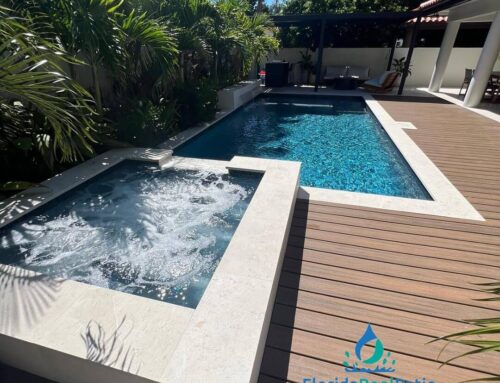Understanding how to find a leak in an above-ground pool may be simpler than you think. If the water level in your pool is lower than usual or if you’ve noticed your skimmer sucking in air while you were enjoying a warm day by the pool, these could both be indicators of a potential pool leak. Detecting a leak in an above ground pool is typically straightforward, as all the plumbing and mechanical components are exposed due to the pool’s above-ground location.
Preparing for the Leak Detection Process
Leaks can occur in several places: plumbing lines, machinery, or any area with a penetration. Before you start troubleshooting, it’s important to carefully observe the condition of each of these areas. Pay attention to the water level, as it can provide clues about the source of the leak. For larger leaks, try to estimate the amount of time it took for the leak to become noticeable after the last time the pool was filled.
Safety Considerations
Repairing a leak in a pool always carries certain risks, including water loss or potential damage to nearby property. Before starting any repair work, it’s crucial to be aware of your surroundings. Ensure that there are no sharp objects or tools in the vicinity that could cause additional damage. If you observe water escaping from the pool in unexpected places, don’t hesitate to call a professional immediately.
What You’ll Need
Equipment and Tools
- Teflon tape
- pH testing liquid
- Silicone
- Repair kit for underwater patches
Materials
- 6-1 Screwdriver (for hose clips)
- Caulking gun
- Small, medium, and large Channel Locks
- Open-ended wrench set
How to Find a Leak in an Above Ground Pool: Step-by-Step Guide
1. Turn Off the Pump
Turn off the pump. Keep the water as still as possible to help locate the leak. Use the pH-testing liquid to check if the water is still draining.
2. Water Level Observation
Take note of the water level. If the water level is lower than the skimmer’s mouth, there may be a pool leak. The leak is likely in the mechanical system or the penetrations. Follow steps 3, 4, and 5 to address this. If not, evaluate the liner using steps 6 and 7.
3. Check the Penetrations for Leaking
Inspect the exposed pipes for any wetness or puddles around fittings and connection points. This could indicate a leak. Stand on the edge of the pool, look into the pool, and spray a large amount of liquid in the area around the return fittings and skimmer’s mouth. If there is a problem, you will see the liquid being sucked up into the surrounding area. Use a screwdriver to replace the gaskets, which can be found at your local pool supply shop.
4. Check the Pump Motor Connection
Examine the connection between the pump motor and hose. Look for any nearby puddles or moisture. If you find any, trace the water trail to the suspected joint. You may discover a cracked or loose hose, a loosely secured hose clamp, or a threaded connection. It is better to replace a cracked or loose hose than to risk expensive repairs. The pool motor is designed to be cooled with water, and running it dry could cause it to burn. Replace the cracked hose with one of the same length and size, securing both ends with hose clips.
If you are comfortable with minor mechanical work, you can fix the problem yourself if it’s coming from a screwed fitting. Close the skimmer’s mouth using a stop plate, then turn the multiport to the closed position. If the return valve is located outside the pool, close it as well. Drain the section by removing the hose from the threaded pipe using channel locks. Apply silicone liberally to the threads, then rethread the hose using channel locks, being careful not to overtighten it. Stop immediately once you feel resistance.
5. Check Your Pool Filter
Some pool filters may have leaking drain plugs. If you find that this is the source of the leak, apply silicone to the threads and retighten the screw securely.
Most pool filters also have a pressure gauge and a release valve. If you suspect a leak from the valve release, tighten the valve. If it doesn’t tighten, stop and replace the filter. Take the model and make of your filter to your local pool store.
If the gauge fitting is leaking, use a wrench to remove it. Apply Teflon tape to the threads when reattaching the gauge fitting. To apply the Teflon tape correctly, hold the gauge in your left hand and apply the tape towards you. When screwing in the gauge again, the Teflon tape should stay on the threads without unraveling.
WARNING
If you notice water leaking between the motor and housing of your pump, call a professional. This indicates that the spring-loaded mechanism in the motor is no longer functioning and needs to be replaced. Repairing this requires disassembling the pump and electrically disconnecting the motor.
6. Check for Liner Rips Around Ladders and Stairs
If the water is below the skimmer’s mouth and return fitting and there are no visible penetrations, there is a high probability that the liner is torn. The water will stop leaking when it reaches the level of the tear. To find the leak, inspect the area where ladders, stairs, or other objects rub against the wall or floor of the liner. Look for tears or wear marks. You can test the pH of any suspicious area by squirting the liquid tester near the spot where the wear is visible. If the leak is present, you will see the liquid being sucked in.
Follow the instructions provided in the repair kit. Don’t hesitate to use more material than you need. These kits are typically used only once or twice in the lifetime of a pool. It’s important to use a large enough piece to properly adhere to the liner and cover the entire tear after applying the glue.
7. Check the Bottom of the Pool
It’s time for a good soaking! Enter the pool carefully with the pH tester and feel around the waterline. If you suspect a small tear, spray some pH-testing liquid on it. If it is sucked up, you have found the leak. Repair it using the underwater patch kit.
If the tear is in a liner seam, call a professional to evaluate it. Even if you patch the tear, it will usually spread along the length of the seam and eventually lead to complete failure.
When to Call a Professional
Not all pools are the same, and some can be much more complex than others. If you find yourself unsure about any of the steps involved in pool repair or if your leak persists despite your efforts, it is recommended to call a professional. This is especially crucial when dealing with leaks originating from intricate areas like the pump or when you notice a tear in the liner at the seam. By reaching out to a professional, you can rely on their expertise to accurately diagnose the issue and provide you with the best repair solution for your specific situation.
Looking for professional pool services in South Florida?
Choose Florida Pool Patio for top-notch quality and exceptional customer service. Our team of experienced professionals specializes in designing and constructing stunning pool patios that transform your outdoor space into a luxurious oasis. From custom designs to efficient installations, we take pride in delivering outstanding results that exceed your expectations.
Contact us today to schedule a consultation and let us create the pool of your dreams in South Florida.
Services We Offer:






